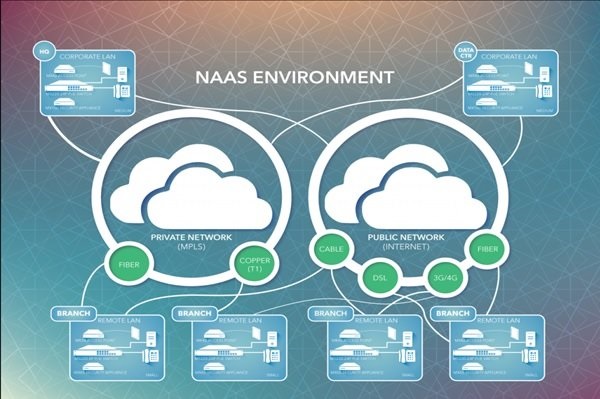What Is NaaS? Network As A Service Is A Cloud Service Model
Network As A Service (Naas) Network As A Service Is A Cloud Service Model In Which Customers Rent Network Services From Cloud Providers.
NaaS allows customers to implement and manage their networks without worrying about maintaining and supporting their network infrastructure.
Like other cloud services, NaaS vendors implement network functions using software, allowing companies to set up their networks independently of the hardware. In this way, companies only need an internet connection.
NaaS can replace virtual private networks (VPNs), multi-protocol tag switching (MPLS), or legacy network configurations. It can also replace in-house network hardware such as firewalls and load reducers.
Newer and more advanced versions of the technology offer a newer model for routing traffic and enforcing security policies, so NaaS significantly impacts enterprise network architecture.
How was NaaS developed?
Companies are configuring their network infrastructure so that the Internet is not a reliable place to do business. Therefore, based on a complex architecture, they use a combination of the corporate, private, and air gap networks in interaction with the Internet, which requires leased communication links.
They require a vast area network (WAN) configuration, and each office location needs its own hardware, such as firewalls, DDoS security mechanisms, load balancers, and more.
In addition, companies need to create custom connections between each location using a method such as MPLS. When employees connect to the Internet instead of the internal network, their traffic must pass through the corporate network infrastructure and VPN before reaching the Internet.
For example, suppose a company’s headquarters are located in different cities, and each branch has a request to connect to the company’s main website.
In that case, the HTTP requests of these branches must pass through the company’s VPN and MPLS links to the headquarters, which is several hundred kilometers away. It eventually enters the Internet.
This network implementation model is inefficient for some business activities in the cloud.
For example, imagine an employee of a branch often uses the SaaS program, meaning that they constantly upload content to the Internet. In this case, the requests issued by the employees of other branches will face problems, and in practice, the network service will slow down.
In addition, as cloud computing becomes more efficient, more capabilities are available to companies through the cloud. Nowadays, efficient capabilities to deal with DDoS attacks, firewalls, load balance, cars, and essential functions implemented in the cloud environment have been added, and there is no need for internal IT teams to create and maintain these services.
To solve these problems and access the capabilities we mentioned, a new model called NaaS was developed, which is a more efficient option than extensive internal networks that require constant maintenance and often create bottlenecks for network traffic.
With NaaS, company employees can connect directly to the cloud services they need through a virtual network managed and secured by an external vendor instead of internal IT teams trying to handle employee demand and keep thinking.
Under the NaaS model, employees of another branch do not have to wait for the required traffic on the internal infrastructure to be balanced before their requests can be sent over the Internet. Instead, they connect to the Internet, log in through their browser, and access all the necessary cloud services.
At the same time, the NaaS provider ensures that it protects their data and directs their web traffic wherever it is required.
NaaS must be described as the product of decades of effort to move from traditional to cloud business processes in many ways. Today, the entire network can be provided as a service instead of software, infrastructure, or operating system.
What are the challenges of NaaS?
Compatibility: NaaS vendor infrastructure may not be compatible with older systems, and older hardware and in-house strategies may not be consistent with NaaS.
Old data centers: Many companies still run essential programs and processes in default data centers rather than in the cloud. This makes migrating to the NaaS model a bit more challenging. Of course, services like Cloudflare Network Interconnect can overcome this challenge.
Vendor Lock: Switching to a cloud service always risks companies becoming overly dependent on a particular service provider. If service providers’ infrastructure breaks down or prices rise, these changes could seriously affect companies.
What are the benefits of NaaS?
Flexibility: Cloud services offer more flexibility and more customization. Changes in the network are made through software, not hardware. IT teams are often able to reconfigure their corporate networks on demand.
Scalability: Cloud services like NaaS are naturally more scalable than traditional hardware-based services. Enterprise NaaS customers can purchase more capacity from the vendor instead of buying, connecting, and turning on more hardware.
Access from anywhere: Depending on how the cloud-based network is configured, users can access it from anywhere – and on any device – without using a VPN, although substantial leverage and access controls should exist. Ideally, all a user needs is an internet connection and credit information to sign in.
No maintenance: The cloud service provider oversees and manages network maintenance, software, and hardware upgrades.
Integrated Security: NaaS allows a single provider to provide network and security services like firewalls, creating better integration of network services and security.
Cost savings: This benefit depends on the seller. However, buying cloud services instead of creating personal services often leads to cost savings. Cloud customers do not need to purchase and maintain hardware; the vendor already has the servers required to provide the service.

